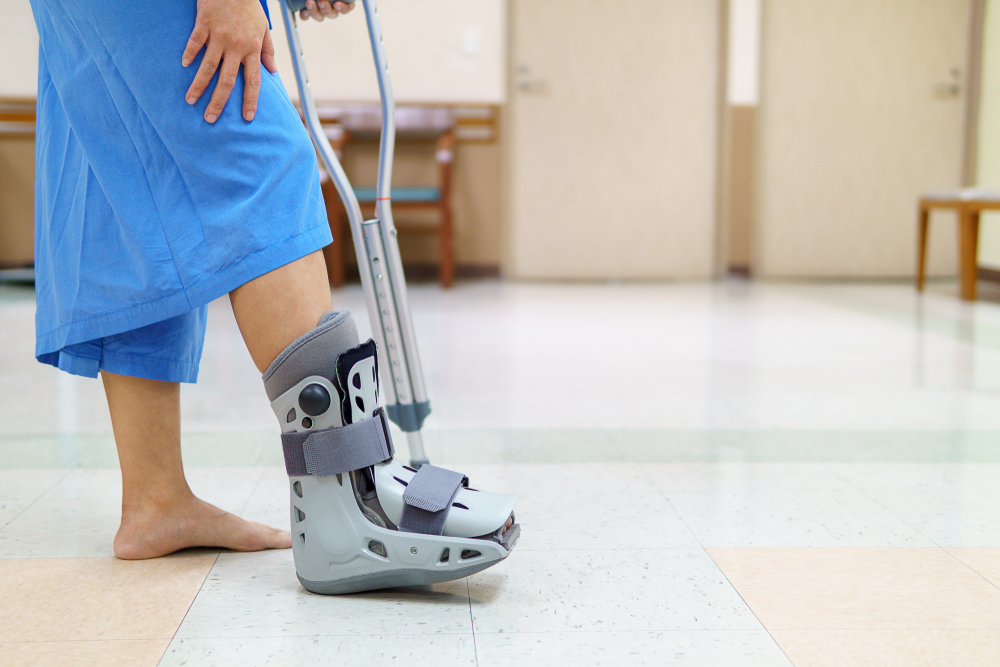Use our convenient online scheduler to book an appointment now.

Ankle fractures are common injuries that can cause severe pain. Generally, they occur during sports or other activities and often require rehabilitation or surgery. The two most common treatment options for ankle fractures are: nonsurgical and surgical.
Treatment of Ankle Fractures
Nonsurgical Ankle Fracture Treatment
There are acute ankle fractures that may be small or inconsequential. These acute ankle fractures usually have intact skin, protecting the fracture edges from the outside environment. Furthermore, these injuries do not result in instability of the ankle joint, nor is the common surface significantly disrupted. There is usually minimal to no displacement in the bones involving the ankle joint.These ankle injuries can be treated nonoperatively.
How do we do that?
Essentially, nonoperative treatment consists of symptomatic treatment, protection, time for bone healing, and rehabilitation. These treatment options commonly include a cast or walking boot.
Symptomatic treatment typically includes ankle elevation, mild compression, and ice to reduce swelling and pain. Over-the-counter analgesics or, on occasion, short-term narcotic pain medications may be prescribed for ankle pain.
Walking Boot and Crutches

A short cast or walking boot provides comfort and protection from further injury. In some tiny fractures, a brace or sleeve may be all that is necessary. These fractures are stable, so usually, weight-bearing on the injured leg is permitted and even encouraged once the pain is better controlled.
These fractures typically mend together within six to eight weeks. However, the fracture is often healed enough to enable safe rehabilitation. Usually, we can discontinue the immobilization and protection by six to eight weeks after the injury.
Surgical Ankle Bone Fracture Treatment
A broken ankle bone with displacement of the bone or joint surface is usually considered an unstable ankle injury and likely will require surgical intervention. If there is an open wound and a broken ankle this will also require surgical intervention.
Open Fractures
External Fixation
Open fractures (often called compound fractures) typically require emergent treatment. Because the overlying skin is disrupted, this type of fracture is exposed to the outside environment. This exposure can sometimes lead to gross contamination by dirt, gravel, sweat, and other debris. Even when gross contamination is not apparent, microscopic contamination can occur.
Either way, the contamination can lead to infection and can adversely affect fracture healing. As a result, when the fracture is “open,” urgent antibiotics and surgical cleaning are required.
Furthermore, definitive fracture stabilization and fixation may not be possible, initially when the fracture is open. In these cases, a minimally invasive provisional treatment with devices that span the fracture over the skin may be used until the skin and soft tissues are healthier. This initial surgery is often later followed by a second, more definitive procedure.
How is the fracture fixed?
Internal Fixation
Whether done as a second procedure or at the initial surgery, ankle surgeons will first align the fractured bones as close to normal as possible. The surgical fixation will use metal plates, screws, and other devices to hold the broken bones in a normal position to restore the joint as close as possible to their pre-injury positions.
Depending on the ankle injury and surgery’s specifics, your ankle surgeon may or may not recommend immobilization after surgery. Similarly, when you can weight-bear on your ankle or begin rehabilitation will also be at the discretion of the ankle surgeon. This decision will be based on the nature of the injury and operative fixation. Nevertheless, it is not uncommon for about six weeks of immobilization and weight-bearing to be avoided.
Recovery Time for Fractured Ankle
Whether your treatment is nonoperative or needs surgical treatment, ankle fracture recovery depends on the specifics of the injured ankle, treatment, symptoms, and needs. This is usually dictated by the fracture pattern, severity of the fracture instability of the fracture, and patient preference. The less severe the injury, the younger the patient, and the less strenuous the needs, the earlier the recovery. Those with more severe injuries, more complex surgery, and particularly those with more athletic or strenuous goals can expect a longer recovery time.
Most patients with fractures treated nonoperatively can expect satisfactory improvement by four to six months, with continued recovery for about six to nine months. Those with surgical treatment usually won’t fully recover before nine months to a year. New emerging research is showing that earlier function rehabilitation is improving patient outcomes and returning patients back to pre-injury level sooner.
Download Ankle Sprains: Treatment and Tips for a Faster Recovery.
Outcomes
Recovery can be long, and issues can arise along the way. Unfortunately, some may have permanent problems. Early worries include wound-healing issues, infection, nerve and blood vessel compromise, and blood clots. Functional deficits such as stiffness, arthritis, areas of incomplete bone healing, pain from the implants, and a need for further surgeries are more long-term concerns.
Fortunately, however, there usually is no need for much worry. Most people who break their ankle will do just fine—ultimately regaining good function and little to no pain. So in most cases, if you’ve broken your ankle, you will ultimately be able to return to your pre-injury lifestyle and activities.
To learn more about recovery, download your guide for Treatment and Tips for a Faster Recovery. To seek medical care for your ankle, request an appointment.
Join our Mailing List
TCO provides patients with orthopedic problems the trusted resources and patient-centered advice they need to “Feel Better. Move Better. Be Better.”
© 2024 Town Center Orthopaedics | All Rights Reserved


